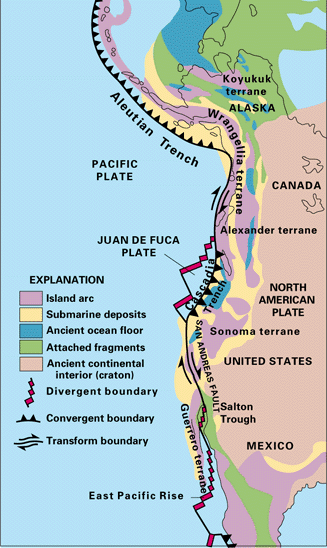

Plate-tectonic movements since the break-up of the supercontinent Pangaea are now fairly well understood. Most scientists believe that similar processes must also have occurred earlier. However, the pre-Pangaea history of plate tectonics is very difficult to decipher, because nearly all of the evidence has been obscured by later geologic and plate-tectonic processes, including the subduction of older oceanic crust, which carried with it the record of magnetic reversals and hotspot traces.
The clues to past plate tectonics can only be found on the present-day continents-in rocks, fossils, and structures older than about 200 million years. This is because the average age of the present-day oceanic crust is about 55 million years; the oldest parts are about 180 million years old, indicating that oceanic crust is entirely recycled every 150 million years or so. By contrast, the average age of the present-day continental crust is about 2.3 billion years, with the oldest known rocks (other than meteorites) dating back 3.96 billion years; these oldest rocks in turn contain minerals (zircons) derived from older rocks, possibly as old as 4.3 billion years.
Continents are built of blocks of crust varying in age, size, rock composition, structure, and fossil assemblage (fauna and flora). In general, most continents have stable, older interiors (called cratons), while the zones bordering the cratons typically consist of younger, structurally more complicated rocks. Some bordering zones are composed of remnants of ancient oceanic lithosphere, volcanic arcs, or mountain ranges -- reasonably interpreted to be products of pre-Pangaea plate tectonics -- that have attached themselves to the cratons. In other zones, however, the geological arrangement of these attached remnants seemed totally chaotic, defying reasonable explanation by geologists until recently. For example, one remnant characterized by a specific kind of rock or fossil of distinctive age may lie next to, or be surrounded by, other remnants characterized by entirely different groups of rocks or fossils, even though they may be similar in geologic age. With the plate-tectonics model, it is now possible to provide more rational explanations for these zones of oddly juxtaposed crustal remnants.

Western North America showing some important plate-tectonics features and the mosaic of far-travelled exotic terranes plastered against the long-lived, stable interior of the continent (see text). (Modified from illustration provided by Oceanus Magazine; original figure by Jack Cook, Woods Hole Oceanographic Institution.)
Scientists now recognize that continental margins are often a mosaic of lithosphere fragments that have been added as a result of plates impinging on one another during movement. The process by which the lithospheric fragments, actually pieces of other plates, became attached to the continents is called accretion. Such fragments can be either continental or oceanic in origin; if they are sufficiently large and share similar geologic characteristics, these fragments are called terranes. Terranes that seem out of place geologically, called exotic or suspect terranes, are composed of pieces of plates that have broken off and then drifted great distances before attaching (accreting) to some other terrane or continental landmass. Western North America is an example of a complex geologic region that is best interpreted as a patchwork of several far-travelled terranes that accreted together after the break-up of Pangaea.
In recent years, the study of terranes (called "terrane tectonics" or "terrane analysis") has become a specialized field within plate-tectonics research. Such studies suggest that plate tectonics has been operating in some fashion since very early in the Earth's history, perhaps as early as 3.8 billion years ago. An intriguing, but sketchy, picture seems to be emerging: There have been several cycles of supercontinent formation, each followed by break-up and subsequent drifting of the fragmented parts. Pangaea itself may have been formed by the aggregation of separate continents that drifted back together after the break-up of an older supercontinent that existed about 550 million years ago.
Dr. David G. Howell (USGS, Menlo Park, California), a specialist in terrane analysis, likens such movement of continents -- as the plates join and separate again and again throughout the Earth's history -- to the motion of "lithospheric bumper cars." There are several important differences, however: this imaginative comparison ignores the fact that electric bumper cars at amusement parks can each move independently, rather than being parts of an integrated system. And their average speeds are at least 500 million times faster than those of tectonic plates!